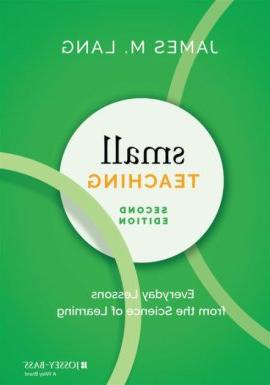Changes to teaching practices can seem daunting, but small adjustments can be both impactful and manageable. James M. Lang’s Small Teaching: Everyday Lessons from the Science of Learning (2021) offers practical strategies for making minor course changes that yield significant benefits. The book is anchored in a baseball analogy: while home runs are often celebrated, playing "small ball"—a strategy of singles, bunts, and base-stealing—can be just as effective for winning games. Similarly, educators can implement minor changes that take only a few minutes but serve as powerful tools to enhance student learning and retention.
Lang argues that “dramatic transformation to one’s teaching is hard work and can prove a tough sell to instructors” (p. 3). Tenure-track faculty must prioritize research and publication, while teaching faculty often have heavy teaching loads each semester. Encouraging minor adjustments is a more practical and accessible approach than advocating for drastic overhauls. According to Lang, the small teaching changes outlined in his book meet three criteria: they are grounded in learning sciences, supported by research demonstrating positive effects in real-world educational settings, and observed by Lang himself to ensure their practicality and effectiveness (pp. 6-7).
The activities and approaches in the book fall into one of three categories: brief classroom or online activities, one-time interventions during a course, or small modifications to course design (pp. 6-7).
Explaining as a Tool for Learning
Lang identifies “explaining” as a critical component of the learning process. Within Bloom’s Taxonomy, demonstrating knowledge shows how well students grasp the material. The "Explaining" chapter offers practical advice for faculty to encourage students to explain concepts. For instance, Lang suggests "Peer Power," where students pair up to teach each other the material (p. 154). Another strategy involves having students develop course materials, allowing them to acquire new information and format it in a way that benefits their peers.
Lang also highlights the use of personal response systems and the "three key steps" method: students answer a question, pause to explain their answer to a neighbor, and then revise their response (p. 156). This approach provides multiple opportunities for students to practice, refine, and deepen their understanding in a low-stakes setting.
Connecting Course Material to Real Life
Connecting course content to real-life applications is essential for student engagement. In the "Connecting" chapter, Lang emphasizes that learning is most effective when students integrate new material with their prior knowledge and make meaningful connections. For example, Lang recommends the use of "connection notebooks," in which students relate course content to their personal experiences (p. 188). This low-stakes activity not only promotes engagement but also helps students recognize the relevance of course material outside the classroom.
Another effective tool is concept mapping, which allows students to visualize connections and use them to solve complex problems. Lang highlights the neuroscience behind this approach: the brain learns by forming associations between new information and existing knowledge, enhancing memory retention, comprehension, and the ability to apply knowledge in new contexts (pp. 189-190).
Final Thoughts
While not every strategy in Small Teaching will apply to every discipline, Lang’s ultimate goal is to inspire small, thoughtful changes that have a meaningful impact. Teaching is an ongoing process, and Lang encourages educators to explore continually teaching pedagogy to support their growth.
Lang also challenges faculty development professionals to collaborate with faculty to brainstorm minor yet powerful changes in course design or delivery to improve student learning. For example, at the start of the semester, faculty might collectively explore ways to enhance the first day of class experience. In this way, instructors can build a sense of community and belonging from day one.
Lang leaves readers with a call to action: think about tomorrow’s class and consider one small change you can make to improve the learning experience (p. 225).




